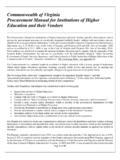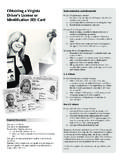Transcription of Virginia Department of Education - inhalants
1 Virginia Department of Education inhalant prevention resource guide Second Printing Isabel Burk, , The Health Network Virginia Department of Education Division of Instructional Support Services Office of Compensatory Programs Box 2120. Richmond, Virginia 23218-2120. (804) 225-2871. January 2001. CONTENTS. Acknowledgments.. 1. Introduction .. 3. Important Terms .. 4. Scope of the Problem .. 5. Abusable Products.. 7. Chemical Ingredients in inhalants .. 9. Policy Approaches to prevention .. 11. inhalants and School Drug Policy .. 13. Why Are inhalants Abused? .. 15. Methods and Materials of Abuse .. 17. Effects of inhalant Abuse .. 19.
2 Signs and Symptoms of inhalant Abuse .. 21. Solvents and Chemicals in School .. 23. When Someone is Huffing .. 25. inhalant Abuse prevention .. 26. Planning for prevention .. 28. Lessons for Grades K-3 .. 29. Lessons for Grades 4-6 .. 37. Lessons for Grades 7-9 .. 55. Lessons for Grades 10-12 .. 69. Resources .. 79. Poison Control Centers .. 81. Bibliography .. 82. ACKNOWLEDGMENTS. Many thanks to the professionals whose time and expertise helped shape this document. The original draft manuscript was produced by: Ms. Jeanne Martino-McAllister Director, Office of Substance Abuse Research - James Madison University Dr. Debra Sutton Department of Health Science - James Madison University Isabel Burk, , The Health Network, New City, New York NATIONAL REVIEW PANEL.
3 Dr. Fred Beauvais Tri-Ethnic Center for prevention Research - Fort Collins, Colorado Mr. Mark Groves The Eden Children's Project - Minneapolis, Minnesota Ms. Kate Malliarakis Office of National Drug Control Policy - Washington, DC. Mr. Harvey Weiss, Executive Director National inhalant prevention Coalition - Austin, Texas Mr. Howard Wolfe Massachusetts inhalant Abuse Task Force - Arlington, Massachusetts Virginia REVIEW PANEL. Ms. Sharyl Adams Substance Abuse prevention Specialist - Chesterfield County Office on Youth Dr. Anne Atkinson President - PolicyWorks, Ltd. Ms. JoAnn Burkholder President - Association of Virginia Student Assistance Professionals (AVSAP).
4 Ms. Marla Coleman (Retired). Director of Guidance - Moody Middle School, Henrico County Public Schools Dr. Fran Meyer, Specialist Comprehensive Health Education - Virginia Department of Education Ms. Nina Pitkin, Coordinator Safe and Drug-Free Schools Program - Fairfax County Public Schools Ms. Myra Shook Educational Coordinator - Virginia Department of Education Dr. Carl Stockton Past President - Virginia Association for Health, Physical Education , Recreation and Dance (VAHPERD). Dr. Gaynelle Whitlock, Director Center for School-Community Collaboration - Virginia Commonwealth University inhalant prevention resource guide 1. 2 inhalant prevention resource guide INTRODUCTION.
5 The deliberate inhalation of fumes, vapors, and gases poses a serious threat to the health and safety of children. Researchers have documented inhalant abuse problems for more than a century, although the general public is not aware of the extent of the problem. Reliable national surveys report that at least one out of five school-age children has abused an inhalant product. (Specific data can be found in the chapter Scope of the Problem. ) This is an unacceptable physical, emotional, cognitive, and social health risk. The problem has attracted much more attention recently, due to publicity about the deaths of young people from inhalant abuse.
6 prevention efforts should be carefully planned and implemented. Research confirms that successful prevention efforts are developmentally appropriate, congruent with other programs/activities, articulated between grade levels, and reinforced to maintain levels of understanding. To enhance skills, change attitudes and promote positive behaviors, repeat, review, and reinforce. It is important to teach the same concepts several different ways, and to discuss inhalant -related issues at various times during the school year when teachable moments present themselves. The enclosed educational materials have been developed for use with students in grades K-12.
7 The guide is designed for adult use with information, a prevention framework, sample lessons, materials, and resources. It can be augmented with other curricula and activities, and can be integrated into different subject areas. Teachers and counselors can use the lessons and materials with classes and small groups. The materials and concepts are also adaptable for special needs students. Before an inhalant prevention program is begun, the school division's drug policy should be reviewed. Refer to the chapter on inhalants and School Drug Policy . for information on how to assess and/or update the policy. inhalant prevention resource guide 3.
8 IMPORTANT TERMS. inhalant abuse refers to the deliberate inhalation of fumes, vapors, or gases to produce a mood-altering effect. This guide contains definitions common to inhalant topics and issues, reasons for use, descriptions of inhalable products and sources, methods of abuse, effects and consequences of inhalant use, an overview of concepts in inhalant prevention , and sample lessons for prevention in grades K- 12. Several terms are used routinely in this document: Huffing: Breathing in fumes or vapors vigorously through the mouth Sniffing: Breathing in fumes or vapors through the nose Bagging: Huffing substances inside a plastic or paper bag Ballooning: Huffing gases from inside a balloon inhalant abusers tend to both huff and sniff, depending on the product and technique of abuse.
9 In this guide , the terms will be used inter- changeably and should be understood to denote both practices. When talking with students it may be best to use the terms huffing or sniffing since students may be more familiar with these terms than with the term inhalants .. Abusable products: This term is used to represent any and all materials that may be selected for abuse. See the chapter on Abusable Products for more complete information and lists of products that are often abused. prevention : prevention is not just Education ! prevention encompasses informa- tion, skills, behaviors, and attitudes. prevention initiatives are planned, sequential and developmentally appropriate.
10 Activities are targeted to specific populations and delivered by trained personnel. inhalant prevention resource guide 4. SCOPE OF THE PROBLEM. Who abuses inhalants ? Several stereotypes misrepresent our lack of accurate information on inhalant abuse. For instance, some people associate inhalants only with certain ethnic groups. Other people are not aware or informed about inhalant abuse, so they assume another group of youngsters is involved. They may subscribe to the it can't happen here theory. City people say kids in rural areas are abusing inhalants . In rural areas, people say it is a problem in the city. Suburban residents say it's not a problem at all.




